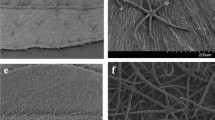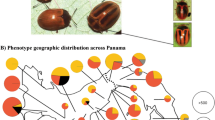Abstract
KETTLEWELL1 gives the frequencies of the three forms carbonaria, insularia and typical of the moth Biston betularia, for many localities in the British Isles. In this paper he points out that the form insularia is extremely variable and has a distribution which would repay more intensive study. He also states2 that the two melanics carbonaria and insularia are controlled by genes at separate loci with no evidence of linkage. He bases his analysis1 of insularia frequency changes during the evolution of industrial melanism on this assumption. However, the extreme variability of the form indicates that it may be controlled in more than one way and some recent breeding results3 suggest that on occasion the form may be controlled by a third allelomorph at the carbonaria locus.
Similar content being viewed by others
References
Kettlewell, H. B. D., Heredity, 12, 51 (1958).
Kettlewell, H. B. D., Heredity, 9, 323 (1955).
Clarke, C. A., and Sheppard, P. M., Nature, 198, 1279 (1963).
Author information
Authors and Affiliations
Rights and permissions
About this article
Cite this article
CLARKE, C., SHEPPARD, P. Genetic Control of the Melanic Form insularia of the Moth Biston betularia (L.). Nature 202, 215–216 (1964). https://doi.org/10.1038/202215a0
Issue Date:
DOI: https://doi.org/10.1038/202215a0
- Springer Nature Limited
This article is cited by
-
Industrial Melanism in the Peppered Moth, Biston betularia: An Excellent Teaching Example of Darwinian Evolution in Action
Evolution: Education and Outreach (2009)
-
The genetics of the Insularia forms of the peppered moth, Biston betularia
Heredity (1977)
-
Melanism in Biston (Lepidoptera: geometridae) in the rural central appalachians
Heredity (1977)
-
Multivariate analysis of variation within the Insularia complex of the moth Biston betularia
Heredity (1977)
-
Genetic control of the melanic forms of the moths Diurnea fagella and Allophyes oxyacanthae
Heredity (1977)





